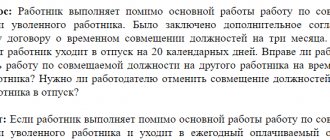There are instructions for maintaining work records. When the employee is reinstated to his previous position, the old entry must be canceled. For example: “record No. ... was declared invalid, reinstated to the previous workplace.” Since it is also necessary to indicate the date of the decision, the date when the court decision was made is indicated here.
The employment contract is not drawn up again. When restored, it simply re-signs under the same conditions. As for the changes, the employee’s personal card is slightly adjusted, where his reinstatement is written down, and also all those days when the person did not appear at the workplace are recognized as forced absenteeism “VP”.
If we take into account the legislative acts, we can see that they clearly regulate the time frame for reinstating an employee to his previous position based on a court decision. After filing a claim with the court, this body must make a final decision within a month. But this period begins to start from the date of dismissal or the date when the order was signed. More precisely, everything starts to happen here from the next day. It must be restored the very next day after the court’s decision. There is also a clause regarding the moment when the employer has time to appeal the decision. He may disagree and appeal the court's decision. If this does not happen, then a month later the decision comes into force. From the next day the person must start work. But if an appeal is filed, then an appropriate determination must be made. From the day it is issued, the employee must be reinstated to his previous position.
This procedure is provided so that it is possible to correctly and competently calculate all possible payments for an employee that are due to him in the event that the manager’s actions are declared illegal. It is not uncommon for an employer to create obstacles for an employee to go to work. In this case, bailiffs begin to act and enforce the court order on reinstatement.
Procedure for reinstatement at work
Based on the analysis of the legislation of the Russian Federation, it follows that the dismissal of an employee is considered legal if the employer simultaneously complies with three conditions:
- there is a basis for dismissal provided for by the Labor Code of the Russian Federation;
- the dismissal procedure has been followed;
- a dismissal order has been issued and there is a corresponding entry in the work book.
If at least one of these conditions is not met, it is possible to challenge this dismissal, however, this procedure is quite complicated, because the final decision in this case will be a judicial act.
Next, we should consider the procedure for reinstatement at work based on the provisions of the law of the Russian Federation, which provide that reinstatement at work is carried out in court:
- The statement of claim is being prepared and the evidence base is being formed;
- Subsequently, the statement of claim is sent to court, the employee defends his position in court;
- After the trial, it is necessary to obtain a judicial act with a mark of entry into legal force;
- After submitting this document to the employer, the latter cancels his dismissal order;
- An entry about the invalidity of the dismissal is made in the employee’s work book;
- The employee returns to his immediate duties.
This procedure reflects how to correctly reinstate an employee by a court decision, and to resolve this issue, you should contact our experienced lawyers and labor dispute lawyers.
Recording in labor
The return of an enterprise employee to his previous workplace is accompanied by an entry in the work book. Previously entered information is considered invalid.
IMPORTANT!
Remember! It is prohibited to correct or cross out anything in this document. You only need to enter the following: “Record No. XXX is invalid. Reinstated in his former position."
When a record is made that the dismissal was declared invalid, the personnel officer, upon application from the employee, will be able to issue him a duplicate work book. An employee of the organization will transfer all information into it, with the exception of the entry that is declared invalid.
In the upper right corner of the first page of the duplicate, the personnel officer makes the appropriate inscription, and on the title page writes “A duplicate was issued in exchange,” indicating its series and number.
Time limits for applying to court for reinstatement at work
The legislator clearly defines the deadlines for an employee to apply to the judicial authorities for protection of his violated rights.
As a general rule, the deadline is set at 3 months from the moment the employee learned of the violation by the employer.
In terms of illegal dismissal, the legislator has defined a special period of 1 month.
It should be noted that if an employee misses the deadline for going to court for good reasons, this deadline can be restored. The issue of reinstating the deadline is decided by the court, for which the employee must draw up a petition to restore the missed deadline.
Actions of an employee upon reinstatement at the enterprise
So, you have agreed that the reason for your dismissal is illegal. Your actions could be:
- Creation of an enterprise labor commission
- Filing a complaint to the State Tax Inspectorate
- Going to court
Appealing the employer's decision by creating a labor commission of the enterprise is advisable in the event of mass dismissal of employees. Remember: the commission at the enterprise may not give you a positive result.
In this case, a complaint is filed with the Federal Labor Inspectorate (GIT). This authority conducts an inspection of the enterprise upon submission of the application. The inspection process determines whether the labor rights of all workers are respected, even if the complaint is isolated. As a result, situations arise, other violations are discovered, and the original complaint remains forgotten.
The State Tax Inspectorate considers the complaint within a month. In practice, claims for compensation often become the reason for the dismissal of a complaint. Therefore, recovery after illegal dismissal through the court is much faster and more effective.
Claim for reinstatement at work
A wrongfully dismissed employee should pay special attention to preparing a statement of claim.
This document must set out all the circumstances of the case related to the illegal dismissal, which reflected the illegality of the employer’s action.
In addition, special attention must be paid to the requirements that you state in court, since it is based on your requirements that the court will make a decision.
USEFUL: learn more about the rules for drawing up a statement of claim for reinstatement at work via the link and in the video
Procedure for a filled vacancy
It happens that a position that became vacant after an employee’s dismissal is already occupied by another person. In such a situation, if there is another vacant vacancy in the organization, the head of the enterprise can transfer a new employee to it (with his consent).
If there are no vacancies, there is only one way out - termination of the employment relationship. For this case, the law has provided a special basis, which is given in the documents. An employee who occupies someone else’s position is fired according to a template: they draw up a document and put a mark in the work book. It should be noted that such a situation does not arise at the whim of the organization, but as a result of unforeseen circumstances. When making an entry in the work book, you need to refer to clause 2, part 1, art. 83 Labor Code of the Russian Federation. This section of the code governs the termination of an employment contract due to the reinstatement of an illegally fired employee.
Reinstatement through court
- For a positive outcome of the case (meaning a decision in favor of a former employee of a particular enterprise in a dispute with the employer), it will be necessary to conduct a difficult analysis of the circumstances, collect data and information that is significant for the evidentiary fund.
- Application - a lawsuit in court for reinstatement with a request to protect the employee’s honest name, his position and the wages due to him (including for the days of illegal dismissal) is a mandatory condition for starting the procedure with which the dismissed employee will go to court.
- While the employees of the judicial apparatus are considering the claim received by them, the employee who suffered from the actions of the employer and our labor lawyer begins to collect significant evidence in favor of protecting the interests of the dismissed employee.
Professional reinstatement in court is based on the following arguments:
- documentary evidence of the employee’s presence at the workplace on the day that was indicated by the employer as “truancy”;
- evidence in favor of the fact that the employee was not at a permanent “labor point” due to the execution of instructions from his direct supervisor;
- photo and video recording of an employee’s presence in the team (evidence of a false accusation against a specific person);
- medical certificates, laboratory results, x-rays and medical commission reports providing information that the employee had a good reason for absence from work due to health reasons;
- eyewitness accounts (testimony of colleagues, clients, partners and managers of other companies who were close to a specific employee on the ill-fated day).
The entire collected evidence base can influence the judge’s decision if the court considers the evidence to be true and significant in reaching a verdict in a particular case.
The services of a professional lawyer in this case will help tip the scale of justice in favor of the client.
ATTENTION: watch the video on the topic of protecting the labor rights of an employee, and also subscribe to our YouTube channel to be able to receive free online legal advice through comments on the video.
Employer's liability
The first thing an employer may face if a court decision to reinstate a person at work is untimely is payment of the enforcement fee. It begins to “drip” from the first day of the violation. Here the bailiff begins to act and makes the appropriate decision. According to this document on the collection of the enforcement fee, a new date is indicated by which the employee must begin work. If there is another violation, the manager will have to pay again. In addition, a protocol on an administrative offense is drawn up, according to which the employer faces not only a fine, but also indicates the need to provide the employee with the opportunity to start work before the next date. As for the fine, it can reach up to 70,000 rubles.
If the head of the enterprise commits these violations, then suspension of his activities may be applied as a punishment. This will make the employer's situation even worse, all because of one employee.
All this suggests that before an employer decides to fire an employee, it is necessary to very correctly calculate all the pros and cons. In this case, under no circumstances should his rights be violated. One such dismissal and subsequent reinstatement of the employee to his previous place will incur serious losses for the manager. In addition to the mandatory payments, you will have to pay additionally the refinancing rate on the day the decision is made. In addition, when the employee is not returned to work on time due to the fault of the employer, he will have to pay, in addition to the enforcement fee, an administrative fine. In certain situations, the activities of an enterprise may be suspended for a certain period.
Save
Save
Save
Save
Compensation for reinstatement by court
If the claims of a wrongfully dismissed employee are satisfied, the latter has the right to recover a number of compensations from the employer:
- Wage . The employee has the right to recover wages from the employer for the period when he did not work due to the employer’s fault, in connection with illegal dismissal;
- Compensation for moral damage in the event of satisfaction of demands for reinstatement at work, the court recovers a certain amount in favor of the employee as compensation for moral damage, its amount varies based on the moral suffering caused to the employee;
- Legal costs for a lawyer . Do not forget that according to the civil procedural code, the losing party is required to recover legal costs in favor of the opponent. In this case, the employer will be required to compensate for the costs of a lawyer or lawyer acting in the interests of the employee.
- Judicial practice on this issue is inclined in favor of the employee, because based on the law, it is the employer who bears the burden of proving the legality of dismissal and compliance with the entire procedure for dismissing the employee.
Compensation for illegal dismissal of an employee
To determine the amount of monetary compensation, you need to calculate all payments due during absence from the workplace, including vacation pay for this period. If the plaintiff has taken another, lower-paying job, he has the right to submit a formal request for compensation for the lost difference in income. And in case of problems with employment due to an incorrectly filled out work book, the dismissed employee has the right to demand payment of moral compensation.
If a situation arises when the employer refuses to pay compensation ordered by the court, the writ of execution is submitted to the FSSP. In this case, the defendant is given a deadline for payment. In case of delay, the bailiff has the right to seize funds in the company’s accounts and transfer them to the plaintiff.
Payment of monthly income for the period of forced absence is mandatory, even if the worker has renounced claims for reinstatement to his old job.
If a situation arises when the position to which the employee is being reinstated is already occupied or eliminated, the employer is obliged to offer a position equivalent to the previous one, or to remove the employee occupying this position. Elimination is possible only if the employee is legally reinstated and the employee being removed agrees to be transferred to another job. To resolve disputes about illegal dismissal from work, it is recommended to contact trusted legal organizations.
Sample order for reinstatement at work by court decision
Order No. 35-k on the reinstatement of I.G. Kaplina
Pursuant to the decision of the Leninsky District Court of Kursk dated December 13, 2012 in civil case No. 3-15478/12
I ORDER:
1. Cancel order No. 25-k dated October 25, 2012 “On termination (termination) of an employment contract with an employee (dismissal).”
2. Allow Irina Grigorievna Kaplina to perform her job duties as an accountant-cashier from December 15, 2012.
3. Head of the HR Department M.A. Nikishina:
- notify I.G. Kaplin about the cancellation of the dismissal order, as well as about the date from which she must begin work;
— make corrections to I.G.’s personal card and work book. Kaplina.
4. Chief accountant M.A. Thunderous:
- pay I.G. Kaplina’s average earnings during forced absence were 25,152 rubles;
- also pay compensation for moral damage in the amount of 1000 rubles.
Reason : writ of execution dated December 13, 2012 N 000154.
What needs to be done, besides ordering reinstatement
The head or other authorized person of the organization makes changes to the time sheet. Those days when an illegally dismissed employee was absent from the enterprise are recognized as forced absences. They are marked with a special code with the symbols “PV” or the numbers “22”. Subsequent appearances are marked in the usual manner, with the letter “I”.
If the decision to dismiss due to reduction has been challenged, the company changes the staffing table. For this purpose, an order is drawn up (in any form). This paper is the basis for including the position on the staff.
You also need to restore your employee card. There are no regulations for issuing a card.
An example of making an entry in a work book about an employee’s reinstatement at work
| date | Information about hiring, transfer to another permanent job, qualifications, dismissal (indicating reasons and reference to the article, clause of the law) | Name, date and number of the document on the basis of which the entry was made | |||
| number | month | year | |||
| 1 | 2 | 3 | 4 | ||
| 8 | 21 | 03 | 2011 | Employment contract | Order |
| terminated due to | from 03/21/2011 | ||||
| repeated | N 35-k | ||||
| failure without | |||||
| good reasons | |||||
| labor responsibilities | |||||
| an employee who has | |||||
| disciplinary action, | |||||
| paragraph 5 of part one | |||||
| Article 81 of the Labor Code | |||||
| Russian Federation | |||||
| Chief seal | |||||
| HR Department Maslennikov | |||||
| Worker Alexandrov | |||||
| Society with limited | |||||
| responsibility | |||||
| "TorgKomplekt" | |||||
| (TorgKomplekt LLC) | |||||
| 9 | 01 | 11 | 2011 | Entry number 8 | Order |
| invalid | from 01.11.2011 | ||||
| restored to the previous one | N 47 | ||||
| work | |||||
Cases when the decision to dismiss will be illegal.
To answer the question posed, let’s consider the case of dismissal of an employee under clause 9, part 1, art. 81 of the Labor Code of the Russian Federation - the adoption of an unjustified decision by the head of an organization (branch, representative office), his deputies and the chief accountant, which resulted in a violation of the safety of property, its unlawful use or other damage to the organization’s property. It is dismissal on the above grounds that is most often recognized by the courts as illegal.
It should be noted that on this basis it is possible to terminate an employment contract only with the head of an organization (branch, representative office), deputy head and chief accountant, and only in cases where they make an unfounded decision, which entails a violation of the safety of property, its unlawful use or other damage to the property of the organization.
According to Part 1 of Art. 273 of the Labor Code of the Russian Federation, the head of an organization is an individual who, in accordance with the Labor Code of the Russian Federation, other federal laws and other regulatory legal acts of the Russian Federation, laws and other regulatory legal acts of the constituent entities of the Russian Federation, regulatory legal acts of local government bodies, constituent documents of a legal entity (organization) and in accordance with local regulations, manages this organization, including performing the functions of its sole executive body.
Consequently, on the basis provided for in paragraph 9 of Part 1 of Art. 81 of the Labor Code of the Russian Federation, the head, his deputy and the chief accountant of any legal entity, regardless of the form of ownership, can be dismissed.
Paragraph 48 of the Resolution of the Plenum of the Armed Forces of the Russian Federation dated March 17, 2004 No. 2 “On the application by the courts of the Russian Federation of the Labor Code of the Russian Federation” states that when deciding whether the decision was unfounded, it is necessary to take into account whether the above-mentioned adverse consequences occurred precisely as a result making this decision and whether they could have been avoided if another decision had been made. At the same time, it is the employer’s responsibility to prove the occurrence of adverse consequences as a result of an unjustified decision being made by the manager, deputy manager and chief accountant.
Thus, the employer must prove not only the unreasonableness of the decision and the existence of damage, but also the cause-and-effect relationship between the employee’s adoption of an unreasonable decision and damage to the organization’s property, which is often very difficult to do.
Arbitration practice.
Let's consider a controversial situation that was dealt with in a regional court. The Determination of the Nizhny Novgorod Regional Court dated January 19, 2010 in case No. 33-254 states: Order No. 16 dated September 21, 2009 and. O. the director of the organization, citizen V., was dismissed for making an unfounded decision that resulted in a violation of the safety of property, its unlawful use and (or) other damage to the organization’s property (clause 9 of Article 81 of the Labor Code of the Russian Federation).
From the case materials and the cassation appeal, it is clear that the chief accountant V. was dismissed for making an unfounded decision to pay for polycarbonate according to estimate No. 87 dated 06/01/2009 to the contractor on the basis of the acceptance certificate for the construction of the facility, while she made the decision on the write-off of the specified material (polycarbonate) according to the act dated April 30, 2009 for the equipment of a facility under construction, as well as for the unjustified write-off of the specified polycarbonate in April 2009.
From the explanations presented in the case materials and... O. director of the organization, it follows that on 06/01/2009 the enterprise entered into contract No. 07/06, according to which the contractor undertakes to carry out a set of works on the installation of the facility under construction in accordance with the estimate No. 87. The specified calculation provides for the use of polycarbonate in the amount of 20 square meters. m in the amount of 4,206 rubles. The cost of polycarbonate is included in the total estimated cost of RUB 27,595. The head of the organization in his explanation indicates that, according to the work acceptance certificate dated June 15, 2009 No. 07/06, the organization accepts the result of the work, and the chief accountant V. makes an unfounded decision to transfer the full amount of funds in the amount of 27,595 rubles, despite what she knew about the use of polycarbonate purchased by the organization in April 2009 in these works.
However, the employer did not present to the court evidence of adverse consequences for the organization as a result of the actions of chief accountant V., such as violation of the safety of property, its unlawful use or other damage to the organization’s property.
As follows from the case materials, according to the inspection report of material assets dated September 10, 2009, drawn up with the participation of the organization’s administration, polycarbonate in the amount of 20 square meters was found in the warehouse. m, which was purchased for equipment of the facility under construction. This circumstance casts doubt on the fact of violation of the safety of property, its unlawful use or other damage to the property of the organization, in this case by the plaintiff.
The defendant’s reference to the fact that in July 2009 it was revealed that the volume of work performed did not correspond to the estimate No. 87, which was recorded in the audit report of the financial and economic activities of the organization dated July 21, 2009, cannot be taken into account by the judicial panel as evidence of unreasonable actions of the chief accountant V., since payment on June 16, 2009 under the contract for the installation of a facility under construction by payment order No. 151 was made after the parties signed on June 15, 2009 the acceptance certificate for the work performed, according to which the contract work meets the customer’s requirements established in the contract No. 07/ 06 dated 06/01/2009.
Thus, by a court decision, the chief accountant of the organization was reinstated at work due to the lack of proof of the occurrence of adverse consequences as a result of her making an unfounded decision.
If the employer refuses to comply with the court decision
Such actions are illegal. If the manager refuses to comply with the court decision and the employee is not admitted to the position, the organization may have problems.
The employee has the right to contact bailiffs to initiate enforcement proceedings. The management of the organization in this situation expects penalties, in particular material ones (Article 396 of the Labor Code of the Russian Federation). The amount of the penalty is equal to the average salary of the employee. It is paid to him for each month of refusal to be reinstated at work.
Changing the settings for Compensation for moral damage in ZUP 3
Compensation for moral damage based on a court decision:
- Not subject to personal income tax (Letter of the Ministry of Finance dated July 3, 2017 N 03-04-05/41721)
- Not subject to insurance contributions (Letter of the Federal Tax Service dated May 12, 2017 N BS-4-11/ [email protected] )
In ZUP 3 of Compensation for Moral Damage, the settings do not comply with the law. You will need to correct them using the Group change of details processing (Administration - Maintenance - Data correction - Group change of details).
The results of the processing are irreversible! Therefore, before starting to work with it, be sure to make a backup copy of the infobase.
In processing, we will select Accrual - Compensation for moral damage .

Let's clear the Personal Income Tax Code and change the Type of income, insurance premiums and Type of income, insurance premiums - 2017 to the value Income that is not subject to taxation of insurance premiums .

After the processing is completed, the Moral Damage Compensation will meet the requirements.

Our assistance to employees
Trdat Group specialists are ready to provide dismissed citizens with legal services, which include:
- Consultation on the procedure for reinstatement specifically in the case of our client with a risk analysis;
- Preparation of a claim for reinstatement at work;
- Collection by a lawyer of evidence of illegality of dismissal, work with potential witnesses;
- Submitting a package of documents to the court;
- Attendance at all court hearings;
- Appealing a decision, preparing a response to the defendant’s complaint;
- Support of enforcement proceedings.
The price of a lawyer’s work depends on the complexity of the case and is communicated at a personal meeting with the client.







